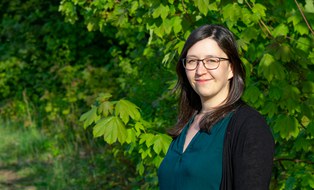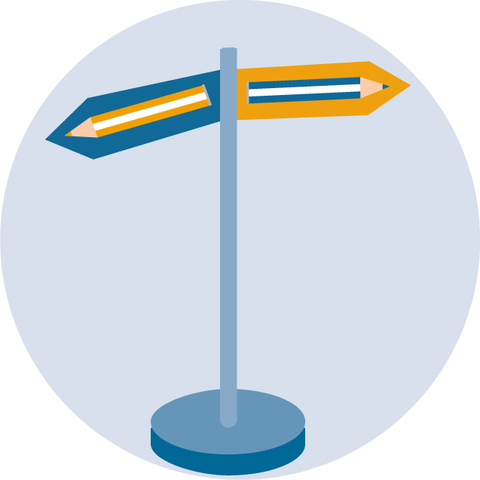15.12.2021
Steile These: Planen ist gut - Drauflosschreiben aber auch
Im Studium gibt es davor kein Entrinnen: Jede und jeder muss früher oder später mindestens eine Abschlussarbeit schreiben. Bereits der Gedanke daran dürfte viele von uns in einen emotionalen Zustand versetzen, der sich irgendwo zwischen leichtem Unbehagen und panischer Angst verorten lässt. Aber woran liegt das? Ganz einfach: Wissenschaftliches Schreiben ist eine hochkomplexe Angelegenheit.
Bis hin zum abgabefertigen Schreibprodukt sind viele und auch sehr vielfältige Teilaufgaben zu bewältigen: Als Schreiber:in einer Abschlussarbeit muss ich zahlreiche Informationen zunächst einmal selbst verarbeiten (etwa den aktuellen Forschungsstand zu meinem Thema durchdringen), weitere Informationen generieren (etwa Daten erheben) und schlussendlich alle gesammelten Informationen in einer logischen und für Außenstehende nachvollziehbaren Art und Weise darstellen und miteinander verknüpfen, so dass ich am Ende – hoffentlich – neue Erkenntnisse generiert habe, die irgendwem irgendwie weiterhelfen. Aber wie entsteht der Text einer wissenschaftlichen Abschlussarbeit? Wie kommen die schlauen Gedanken aus dem Kopf auf das Papier? Wie entstehen Sätze, Absätze, Abschnitte und Kapitel, die dann auch Leserinnen und Leser nachvollziehen können? Viele Wege führen nach Rom, beziehungsweise zum fertigen Text.
Eine mögliche Herangehensweise besteht darin, den Aufbau des Textes zunächst minutiös zu planen und die einzelnen Schritte bis zum fertigen Text abzuarbeiten. Zugegebenermaßen beeindruckt mich ein derartig strukturiertes und geplantes Vorgehen zutiefst. Allerdings musste ich im Verlauf meiner eigenen Schreibbiographie immer wieder feststellen, dass ich persönlich so nicht arbeiten kann. Mir fällt es zu Beginn des Schreibprozesses sehr schwer, mich auf eine detaillierte Gliederung festzulegen. Ich überlege mir zwar vorab, welche grundlegenden Begriffe, Theorien und Konzepte ich erklären muss, damit meine Arbeit verständlich wird, aber die sinnvollste Reihenfolge ist mir meistens nicht sofort klar. Also stürze ich mich zunächst auf einen einzelnen Aspekt (z.B. eine grundlegende Theorie) und formuliere dazu einen Textabschnitt. Dann widme ich mich einem weiteren Aspekt. Indem ich mich mit den Details auseinandersetze, kommen mir Ideen dazu, wie ich alles sinnvoll miteinander verknüpfen kann – ich finde nach und nach den roten Faden. Die detaillierte Gliederung entsteht somit erst beim Schreiben. Auch beim Verfassen einzelner Textabschnitte tue ich mich schwer, wenn ich zunächst einen Plan aufstellen soll. Eine Betreuerin gab mir mal den Tipp, dass ich ausprobieren solle, mir die Inhalte eines Textabschnittes zunächst stichpunktartig zu notieren und erst später in ganzen Sätzen auszuformulieren. Aber je mehr ich mich dazu zwang, erstmal nur Stichpunkte zu notieren, desto mehr verspürte ich den Drang, direkt in ganzen Sätzen „drauflos“ zu schreiben.
Auch Schreibforscherinnen und Schreibforscher haben sich in zahlreichen Studien mit der Frage beschäftigt, wie ein wissenschaftlicher Text entsteht. Grieshammer et al. (2019) unterscheiden auf Grundlage dieser Erkenntnisse fünf verschiedene Schreibtypen. Dazu zählen unter anderem „der Pläneschmieder“ und „der Spontane“. Beide kommen früher oder später ans Ziel – es entsteht Text. Beim Pläneschmieder, bzw. der Pläneschmiederin, dauert es üblicherweise etwas länger, bis ein erster Textentwurf zu Papier gebracht wird, da Pländeschmieder:innen zunächst ihr Vorgehen planen und die Struktur des Textes entwerfen. Spontane bringen hingegen schnell Text zu Papier, benötigen im Nachhinein aber (mitunter deutlich) mehr Zeit für die Überarbeitung.
Ob du zunächst fleißig Pläne schmiedest oder lieber direkt drauflosschreibst, ist eigentlich egal, denn beide Herangehensweisen können zum Ziel führen. Jede Schreiberin und jeder Schreiber sollte für sich selbst erforschen, welches Vorgehen am besten zu den eigenen Vorlieben passt. Ebenfalls hilfreich ist es, Strategien zum Umgang mit möglichen unerwünschten „Nebenwirkungen“ der eigenen Herangehensweise parat zu haben.
Du willst herausfinden, ob du eher zum Planen oder Drauflosschreiben neigst? Der Schreibtypentest kann dir dazu erste Hinweise liefern. Mit deinem Ergebnis kannst du gern in die Schreibberatung kommen. Dort können wir gemeinsam besprechen, welche Schreibstrategien und -techniken zu dir passen:
zum Schreibtypentest (PDF, nicht barrierefrei), Schreibtypentest verkürzt zum Durchklicken (auf OPAL)
zur Terminbuchung der Schreibberatung (auf OPAL)
Literatur: Grieshammer, E., Liebetanz, F., Peters, N., & Zegenhagen, J. (2019). Zukunftsmodell Schreibberatung. Eine Anleitung zur Begleitung von Schreibenden im Studium (4. Aufl.). Schneider Verlag Hohengehren GmbH.
zur Autorin: Betty kam 2018 als Schlüsselkompetenztutorin zum Schreibzentrum der TU Dresden und gibt seitdem Workshops. Das Schreibzentrum war 2018 noch ein Kooperationsprojekt vom Zentrum für Weiterbildung und dem Career Service, seit 2021 sind das Schreibzentrum und das Projekt "Schlüsselkompetenzen@TUD" eigenständige Projekte - und Betty hat sich entschieden, auch die Qualifizierung zur Schreibberaterin am Schreibzentrum zu absolvieren und gibt ab Sommersemester 2022 nicht nur weiterhin Workshops, sondern auch Schreibberatung.
 © Franz Mäge
© Franz Mäge
Wissenschaftliche Hilfskraft
NameBettina Damnik
Schreibberatung, Workshops
Eine verschlüsselte E-Mail über das SecureMail-Portal versenden (nur für TUD-externe Personen).
Dieser Beitrag erschien anlässlich des ersten Schreibzentrumsnewsletters im Dezember 2021. Diese und weitere Newsletter-Ausgaben sind im Newsletter-Archiv des Schreibzentrums verlinkt.
 © TUD
© TUD
Schreibzentrum der TUD
Eine verschlüsselte E-Mail über das SecureMail-Portal versenden (nur für TUD-externe Personen).
Besuchsadresse:
Fritz-Foerster-Bau, Raum 108 Mommsenstr. 6
01069 Dresden
Postadresse:
Technische Universität Dresden
Zentrum für Weiterbildung/
Schreibzentrum der TUD
01062 Dresden
Das Schreibzentrum der TU Dresden (SZD) unterstützt Studierende und Lehrende mit Angeboten zum Planen und Schreiben verschiedener Texte im Studium wie Belege, Protokolle, Seminar- und Abschlussarbeiten und zur Vermittlung des akademischen Schreibens in Lehre und Betreuung. Alle Informationen zu Angeboten und Möglichkeiten der Unterstützung sind in den Bereichen für Studierende und Lehrende zu finden.

